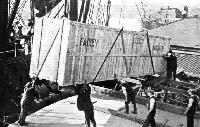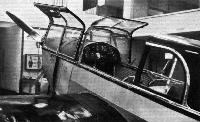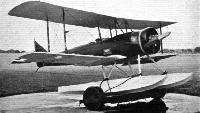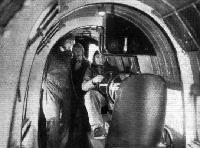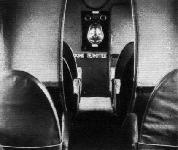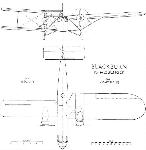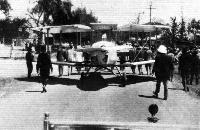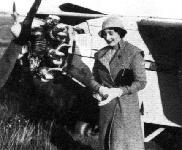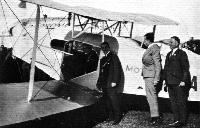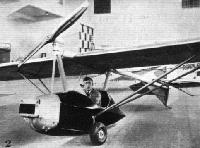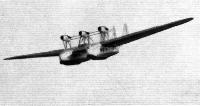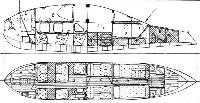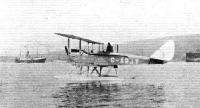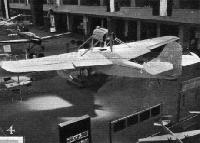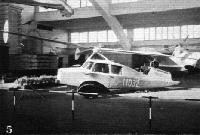Фотографии
-
A FRENCH RECORD BREAKER: The Breguet type 19-8 Observation plane (660 h.p. Gnome-Rhone "Mistral Major" K-14) on which Capt. Signorin recently established two records, viz., 10,400 m. (34,120 ft.) with 500 kg. and 9,400 m. (30,841 ft.) with 1,000 kg.
Самолёты на фотографии: Breguet Br.19 - Франция - 1922
-
Регистрационный номер: VH-UMB NOW A TRAINER: After doing much good service with the R.A.A.F. this D.H.9 (Siddeley Puma) is now the chief training machine of the Victoria Aero Club.
Самолёты на фотографии: De Havilland D.H.9 - Великобритания - 1917
-
Регистрационный номер: VH-UHE, VH-UJC, VH-UQH DE HAVILLAND AIRCRAFT IN AUSTRALIA: Some of the Q.A.N.T.A.S. company's fleet - (left to right) "Moth" (Cirrus III); "Moth" (Gipsy); "Puss Moth"; D.H.61 (Bristol Jupiter XI F); D.H.50 "Giant Moth" (450 Jupiter VI).
Самолёты на фотографии: De Havilland D.H.50 - Великобритания - 1923De Havilland Giant Moth / D.H.61 - Великобритания - 1927De Havilland Gipsy Moth / Moth X - Великобритания - 1928De Havilland Puss Moth / D.H.80 - Великобритания - 1929
-
Регистрационный номер: J9131 LATEST VICKERS NIGHT BOMBER: This four-seater biplane is of all-metal construction, and has a wing area of 1,367 sq. ft. The gross weight is 16,400 lb. and the engines are Bristol "Pegasus" type I M.3.
Самолёты на фотографии: Vickers Vanox / Type 150 / 195 / 255 - Великобритания - 1929
-
"IN SUSSEX BY THE SEA": The County of Middlesex Squadron flying their "Wapitis" to the seaside.
Самолёты на фотографии: Westland Wapiti - Великобритания - 1927
-
URBS IN RURE: Three Westland "Wapitis" (Jupiter) of No. 600 (City of London) (Bomber) Squadron flying over Sussex.
Самолёты на фотографии: Westland Wapiti - Великобритания - 1927
-
BRITISH AIRCRAFT FOR SOUTH AMERICA: The last of a batch of Fairey "Gordons" (Armstrong Siddeley "Panther") being embarked and completing an order received from South America.
Самолёты на фотографии: Fairey Gordon / Seal - Великобритания - 1931
-
A NEW TYPE AT THE D.E.L.A.: The Klemm Limousine four-seater is powered by an Argus engine.
Самолёты на фотографии: Klemm Kl.32 / Kl.36 - Германия - 1932
-
Регистрационный номер: G-AAXC Heracles was very imposing as "she" arrived over the hangar at Bristol Airport. The broadcasting van on the left was most ably worked throughout the meeting by Mr. Dick Ashley Hall.
Самолёты на фотографии: Handley Page H.P.42 / H.P.45 - Великобритания - 1930
-
THE WINNER: Mr. M. D. L. Scott, the first in the Race, in his "Puss Moth" (Gipsy III).
Самолёты на фотографии: De Havilland Puss Moth / D.H.80 - Великобритания - 1929
-
Airspeed Type A.S.5
Самолёты на фотографии: Airspeed Courier / AS.5 - Великобритания - 1933
-
Самолёты на фотографии: Airspeed Courier / AS.5 - Великобритания - 1933
-
FOR SEAPLANE TRAINING: An "Avian" (7-cyl. Armstrong-Siddeley Genet Major) with all-metal "boots," which is used for training seaplane pilots at Hamble by Air Service Training, Ltd.
Самолёты на фотографии: Avro Avian / Type 594/616 - Великобритания - 1926
-
Регистрационный номер: K2344 [2] THE SCHOOL HOUSE: This Vickers "Victoria" (Napier "Lions") is used at the Central Flying School for instrument-flying instruction.
Vickers Victoria K2344 - apparently driverless.Самолёты на фотографии: Vickers Victoria - Великобритания - 1922
-
Регистрационный номер: K2344 [2] THE SCHOOL ROOM: A view inside the "Victoria" showing the unique "back to front" arrangement for instruction.
The fiendish instrument-flying cockpit installed in Vickers Victoria K2344.Самолёты на фотографии: Vickers Victoria - Великобритания - 1922
-
Регистрационный номер: G-ABKV [5], G-ABKW [5] BIPLANE OR MONOPLANE? The two Blackburn machines built to settle this question.
Built for comparative experiments, the Blackburn civil monoplane and biplane had a pair of Jaguars each.Самолёты на фотографии: Blackburn CA.15 Monoplane/Biplane - Великобритания - 1932
-
Регистрационный номер: G-ABKV [5], G-ABKW [5] THREE-QUARTER REAR VIEWS: The two Blackburn machines at Brough, ready to go to Martlesham for test.
Самолёты на фотографии: Blackburn CA.15 Monoplane/Biplane - Великобритания - 1932
-
Регистрационный номер: G-ABKV [5], G-ABKW [5] THE BLACKBURN MACHINES: The unusual undercarriage of the monoplane is due to the use of the same points of attachment being used as on the biplane.
Самолёты на фотографии: Blackburn CA.15 Monoplane/Biplane - Великобритания - 1932
-
Регистрационный номер: G-ABKV [5], G-ABKW [5] THE TWO BLACKBURN CIVIL MACHINES: The fuselages, etc., are identical. The engines in both types are Jaguars.
Самолёты на фотографии: Blackburn CA.15 Monoplane/Biplane - Великобритания - 1932
-
Регистрационный номер: G-ABKV [5], G-ABKW [5] ON THE BANKS OF THE HUMBER: The two Blackburn civil machines from above.
Самолёты на фотографии: Blackburn CA.15 Monoplane/Biplane - Великобритания - 1932
-
THE CABIN: A partition divides it into two compartments. Note that smoking is permitted.
Самолёты на фотографии: Blackburn CA.15 Monoplane/Biplane - Великобритания - 1932
-
Blackburn 10 Passenger
Самолёты на фотографии: Blackburn CA.15 Monoplane/Biplane - Великобритания - 1932
-
Самолёты на фотографии: Blackburn CA.15 Monoplane/Biplane - Великобритания - 1932
-
Towing the "Bluebird" to the slipway where the floats were fitted.
Самолёты на фотографии: Blackburn Bluebird / L.1 - Великобритания - 1924
-
Repairs to the engine installation.
Самолёты на фотографии: Blackburn Bluebird / L.1 - Великобритания - 1924
-
The "Bluebird" (Gipsy III) with Flt. Lt. Pudney.
Самолёты на фотографии: Blackburn Bluebird / L.1 - Великобритания - 1924
-
Регистрационный номер: G-ABUA, G-ABVP THE START: Capt. Dancy "dropping the flag" for Miss Crossley who flew her "Swift" into third place in the Heston-Cardiff Race. Next to her in the line, Mr. Jackaman's Monospar looked very resplendent.
Самолёты на фотографии: Comper Swift / CLA.7 - Великобритания - 1930General Aircraft Monospar ST-4 - ST-12 - Великобритания - 1932
-
Регистрационный номер: G-ABUS THE A.A. HOLD ON: Sterling work was done by the A.A. Air Squad in securing the aeroplanes from the force of the elements.
Самолёты на фотографии: Comper Swift / CLA.7 - Великобритания - 1930
-
Регистрационный номер: G-ACTF, VT-ADO WITH THE POBJOY R.: The Comper "Swift," designed by Flt. Lt. N. Comper (note the Indian registration letters)
As VT-ADO awaiting collection at Hooton in August 1932.Самолёты на фотографии: Comper Swift / CLA.7 - Великобритания - 1930
-
THIRD HOME: Miss "Delia" Crossley, who finished third, in her Comper "Swift" (Pobjoy).
Самолёты на фотографии: Comper Swift / CLA.7 - Великобритания - 1930
-
AT GLOUCESTER: (L to R) Mayor of Gloucester (in the cabin), the City High Sheriff, Col. the Master of Sempill, Mr. A. King (managing director, Westgate Motors), at the opening of the Westgate Motor House Aerodrome. The City officials took a flight over Gloucester in the "Fox Moth" (Gipsy III) with Col. Sempill.
Самолёты на фотографии: De Havilland Fox Moth / D.H.83 - Великобритания - 1932
-
RARELY have we had the privilege of publishing photographs of such a perfect formation flying as that depicted here. They show No. 408 Fleet Fighter Flight, of H.M.S. "Glorious," commanded by Lt.-Com. E. M. C. Abel-Smith, R.N. The aircraft are Hawker "Nimrod" fitted with Rolls-Royce "Kestrel" engines
Самолёты на фотографии: Hawker Nimrod - Великобритания - 1931
-
Регистрационный номер: S1585 Самолёты на фотографии: Hawker Nimrod - Великобритания - 1931
-
Of the two machines shown in 3 that in the background is the Messerschmitt M.31, a most graceful-looking monoplane, while in the foreground is the new Fieseler 4 with Argus AS 16 horizontally-opposed engine.
Самолёты на фотографии: Fieseler F-4 / F-5 - Германия - 1933Messerschmitt BFW M.29 / M.31 - Германия - 1931
-
Регистрационный номер: G-ABUZ UNRESTRICTED OUTLOOK: Our photograph emphasises the fact that the pilot of a Monospar never suffers from being unable to see in any direction
Самолёты на фотографии: General Aircraft Monospar ST-4 - ST-12 - Великобритания - 1932
-
IN ROME: A cheerful group before the Monospar in Rome. Mr. H. J. Stieger is fourth from the right and Flt. Lt. Schofield third from the left.
Самолёты на фотографии: General Aircraft Monospar ST-4 - ST-12 - Великобритания - 1932
-
Регистрационный номер: G-ABXL The Granger "Archaeopteryx" flying at Nottingham.
Самолёты на фотографии: Granger Archaeopteryx - Великобритания - 1930
-
2 seems to be a modern designer's version of the old German Grade monoplane, but with shaft and bevel-gear transmission to the airscrew.
Самолёты на фотографии: Messerschmitt BFW M.33 - Германия - 1932
-
The Savoia-Marchetti S.66 twin-hull, three-engined monoplane in flight.
Самолёты на фотографии: Savoia-Marchetti / SIAI S.66 - Италия - 1931
-
THE SAVOIA-MARCHETTI S.66: Internal arrangement of one of the hulls. A = Forecastle and entrance to main cabin. B = Main passenger cabin. C = Passengers' luggage compartment. D = Sleeping berths and aft entrance. E = Freight and mail compartment.
Самолёты на фотографии: Savoia-Marchetti / SIAI S.66 - Италия - 1931
-
Savoia-Marchetti S.66 3 Fiat A22-R 500 h.p. Engines
Самолёты на фотографии: Savoia-Marchetti / SIAI S.66 - Италия - 1931
-
Landing the Hermes II "Spartan" for operation with the East Greenland Air Survey.
Самолёты на фотографии: Simmonds Spartan - Великобритания - 1928
-
Регистрационный номер: VH-UKU SEEN FROM A "SHELL" AEROPLANE: The winner of the Mildura (Victoria) Aerial Derby, Australia. The pilot of the Victoria Aero Club "Moth" is Mr. H. Hughes.
Самолёты на фотографии: De Havilland Gipsy Moth / Moth X - Великобритания - 1928
-
Регистрационный номер: G-ABJT A PRIVATE OWNER'S SEAPLANE: Mr. C. W. T. Guthrie's "Moth" seaplane at anchor in the Gare Loch; as described in "Flight" last week, it was delivered to Scotland by Capt. Stocken recently.
Самолёты на фотографии: De Havilland Gipsy Moth / Moth X - Великобритания - 1928
-
Регистрационный номер: G-AASE "THE LUXURY AIR YACHT": The Supermarine mono-flying-boat, Windward III (3 Armstrong-Siddeley "Panthers"), on which Mrs. J. J. James ,s making a Mediterranean cruise, piloted by Capt. H. C. Biard.
Самолёты на фотографии: Supermarine Air Yacht - Великобритания - 1930
-
Регистрационный номер: G-ABVG WITH THE POBJOY R.: Mr. P. G. Miles' "Satyr," the first information of which was given in FLIGHT for August 5, 1932.
Самолёты на фотографии: Miles Satyr / M.1 - Великобритания - 1932
-
THE NEW "LIBELLE": In the upper photograph, showing the machine at rest on the water, the port wheel of the undercarriage can be seen retracted into the side of the hull. The middle photograph shows the machine being hoisted into the water, with the wheels lowered. In the lower picture one obtains a good idea of the absence of extra drag when the undercarriage is raised.
Самолёты на фотографии: Dornier Do.12 Libelle III - Германия - 1932
-
A rather fine view of the new Dornier "Libelle" amphibian. Note the openings in the engine cowling through which the propeller draws the air to assist in cooling. What the effect is on the airscrew efficiency is not known.
Самолёты на фотографии: Dornier Do.12 Libelle III - Германия - 1932
-
Регистрационный номер: D-11032 A not unattractive project is shown here. From the absence of an airscrew it is inferred that the machine is a helicopter, with engine-driven windmill. Note control surfaces on rotor blade tips.
Самолёты на фотографии: Ambi-Budd Autoflugzeug - Германия - 1932
-
THE "MULTI PRO": This very pretty machine is the work of H. Pander &. Zonen, of The Hague, Holland, all Pander machines it shows exceptional skill in the use of wood, particularly in the application of plywood, machine is a side-by-side two-seater, and the engine is a Pobjoy "R."
Самолёты на фотографии: Pander Multipro - Нидерланды - 1932
-
THE KLEMM "POPULAR": The Klemm L.33, it will be seen, is a high-wing monoplane. It is fitted with a 15-18-h.p. D.K.W. engine, and will be marketed at 4,500 marks (approximately L300 at present rate of exchange).
Самолёты на фотографии: Klemm Kl.33 - Германия - 1932
-
THE MARCEL BLOCH 90: The engine is a de Havilland Gipsy III.
Самолёты на фотографии: Bloch MB.90 - Франция - 1932
-
Самолёты на фотографии: Caproni Stipa - Италия - 1932
-
Самолёты на фотографии: Caproni Stipa - Италия - 1932
-
Самолёты на фотографии: Jourdan Helicoplane - Франция - 1910
-
Самолёты на фотографии: Jourdan Helicoplane - Франция - 1910
Статьи
- Flight






